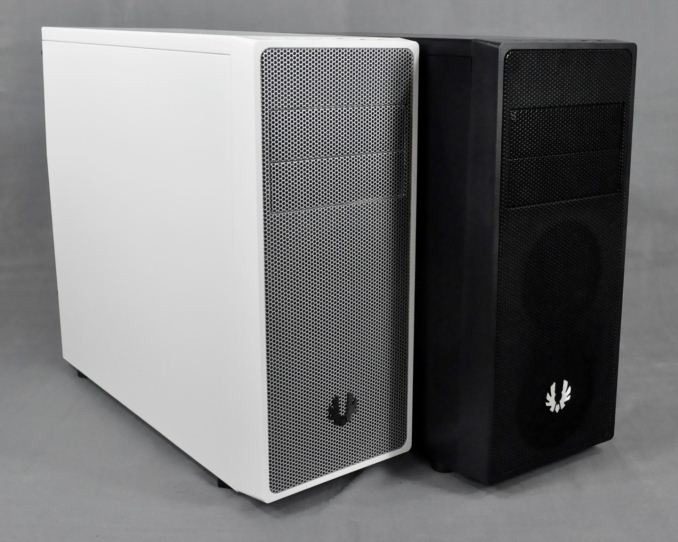BitFenix Neos Case Review
by E. Fylladitakis on January 21, 2015 9:00 AM EST- Posted in
- Cases/Cooling/PSUs
- bitfenix
- Case
BitFenix Neos Exterior
As we mentioned on the previous page, the Neos is available in multiple chassis/faceplate color combinations. BitFenix supplied us with both the black and white chassis of the Neos, shipping us a black/black and a white/white model of the case. The company also supplied us with the corresponding windowed side panels of each model.
Aesthetically, the Neos is based on a very simple, straightforward, and clean design. The chassis is just an ordinary SECC steel body, without any aesthetic modifications, while the faceplate basically is a metallic mesh on a plastic frame. The only aesthetic improvement is the rounded edges of the faceplate and the metallic mesh. This does not mean that the Neos is bad looking – a minimalistic design actually is much better than an extravagant "aggressive" appearance for most users.
Structurally, the Neos makes use of a thin (0.7-0.8 mm) SECC steel chassis, which is adequate for a case of this size and acceptable considering the price range of the case. The plastic frame of the faceplate seems good as well. The metallic mesh however can be an issue, as it can be easily disformed or damaged, especially when handling the 5.25" covers if you're not careful.
Aside from the aluminum company logo, the faceplate of the Neos is entirely plain. BitFenix moved the I/O ports and buttons to the top of the plastic faceplate frame. From left to right, we can see a round power on button, a rectangular reset button, the 3.5" audio jacks, two LED lights (power and disk activity), one USB 2.0 port, and one USB 3.0 port. (Note that providing a single USB 2.0 and USB 3.0 is a bit odd, as they usually come in pairs so effectively you lose one of each with this arrangement.) The positioning of the I/O ports and buttons limited the number of 5.25" bays to just two, but they should be more than sufficient for most users.
The removal of the faceplate reveals two filters. First, a foam-type filter is right behind the metallic mesh of the faceplate – this is sure to get dirty very easily. The second filter is a nylon net-type filter, covering the 120mm intake fan openings.
A look at the back of the case reveals that the Neos has its PSU compartment down at the bottom of the case, as well as two rubber grommets for the tubing of liquid cooling setups. These openings can also be used for cables, if required. The feet of the case are nearly 2.5 cm tall, which is a forced requirement as the intake of the PSU is below the case. A nylon net filter can be found there, removable towards the rear of the case, limiting the amount of dust that will be introduced into the PSU.























54 Comments
View All Comments
graffight - Thursday, January 22, 2015 - link
Page 2 - '3.5" audio jacks’. Assuming you mean 'mm' else that's some propriatory sh*t right there ;DHaravikk - Friday, January 23, 2015 - link
Very uninspiring case; rather than being minimalist it manages to be ugly, and its internal layout is very bog standard and doesn't seem great. It would only take a tiny tweak on behalf of the designer to make mounts for 2x 140mm fans at the front, then another few to make them suitable for mounting a radiator; then we'd be looking at something more serious.However, as usual the design is badly hampered by the unnecessarily common 2x optical bays and a heap of sideways drive bays that hardly anyone will actually use entirely. If you're going to do side-mounting drive bays then why not put them in a line horizontally like the old Mac Pros? As long as airflow passes under them they'll stay plenty cool, throw in a slot-loading optical bay instead and you can save tons of space at the front, freeing you to make the unit shallower (from front to back). Then we'd be looking at something interesting or new, instead it's just a carbon copy of 99% of tower cases with some not very good styling; I'm all for minimalist design, but this one manages to make less look like less.
lazymangaka - Saturday, January 24, 2015 - link
I used the purple model of this for my wife's build. It wasn't too bad to work with, though the cable management certainly could have been better. I don't see any thermal throttling or heating issues, either, with a 4690 and an R9 290. I think if it was the case for my PC and I was having to get into it to tinker more often then it would be more annoying, but in a "set it and forget it" setup I'm not too mad.Really though, I chose it primarily for aesthetic reasons. Purple cases are tough to come by.
camohiddendj - Monday, February 16, 2015 - link
Just as clarification... While this article says you are not able to use an AIO inside this case, I have a Corsair h80i mounted in one just fine.